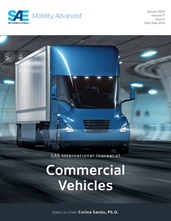With the continuous upgrading of emission regulations for internal combustion
engines, the nitrogen oxide treatment capacity of selective catalytic reduction
(SCR) aftertreatment needs to be continuously improved. In this study, based on
a prototype of SCR aftertreatment, the impact of the arrangement of key
components in the SCR system (urea injector, mixer, and catalyst unit) on
ammonia uniformity was investigated. First, parameterized designs of the urea
injector, mixer, and SCR unit were conducted. Then, using computational fluid
dynamics (CFD), numerical simulations of the established aftertreatment system
models with different parameter factors were performed under a high-exhaust
temperature and a low-exhaust temperature conditions to study the impact of each
individual parameter on ammonia uniformity. Finally, an optimized solution was
designed based on the observed patterns, and the optimized samples were tested
on an engine performance and emission test bench to compare their ammonia
uniformity. The test results showed that the ammonia uniformity of the optimized
solution was improved by 2%–3% compared to the original design, reaching 0.952
and 0.967, respectively.
